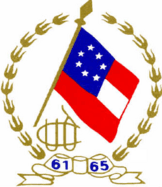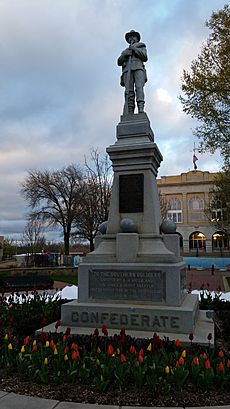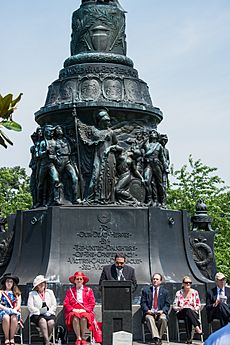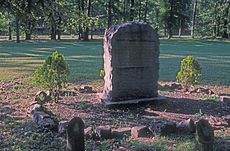United Daughters of the Confederacy facts for kids

Official badge, depicting the "Stars and Bars", the first flag of the Confederacy
|
|

|
|
| Abbreviation | UDC |
|---|---|
| Established | September 10, 1894 |
| Founders |
|
| Founded at | Nashville, Tennessee |
| Type | 501(c)(3), charitable organization, lineage society |
| Headquarters | Richmond, Virginia |
|
Membership (2015)
|
19,000 |
| Jinny Widowski | |
| Publication | UDC Magazine |
| Subsidiaries | Children of the Confederacy |
|
Formerly called
|
National Association of the Daughters of the Confederacy |
The United Daughters of the Confederacy (UDC) is an American neo-Confederate hereditary association for female descendants of Confederate Civil War soldiers engaging in the commemoration of these ancestors, the funding of monuments to them, and the promotion of the pseudohistorical Lost Cause ideology and corresponding white supremacy.
Established in Nashville, Tennessee in 1894, the group venerated the Ku Klux Klan during the Jim Crow era, and in 1926, a local chapter funded the construction of a monument to the Klan. According to the Institute for Southern Studies, the UDC "elevated [the Klan] to a nearly mythical status. It dealt in and preserved Klan artifacts and symbology. It even served as a sort of public relations agency for the terrorist group."
The group's headquarters are in the Memorial to the Women of the Confederacy building in Richmond, Virginia, the former capital city of the Confederate States. In May 2020 the building was damaged by fire during the George Floyd protests.
Contents
Formation and purpose
The group was founded on September 10, 1894, by Caroline Meriwether Goodlett and Anna Davenport Raines as the National Association of the Daughters of the Confederacy. The first chapter was formed in Nashville. The name was soon changed to United Daughters of the Confederacy. Their stated intention was to "tell of the glorious fight against the greatest odds a nation ever faced, that their hallowed memory should never die." Their primary activity was to support the construction of Confederate memorials. The UDC has said that its members also support U.S. troops and honor veterans of all U.S. wars.
In 1896, the organization established the Children of the Confederacy to impart similar values to younger generations through a mythical depiction of the Civil War and Confederacy. According to historian Kristina DuRocher, "Like the KKK's children's groups, the UDC utilized the Children of the Confederacy to impart to the rising generations their own white-supremacist vision of the future." The UDC denies assertions that it promotes white supremacy.
The communications studies scholar W. Stuart Towns notes the UDC's role "in demanding textbooks for public schools that told the story of the war and the Confederacy from a definite southern point of view." He adds that their work is one of the "essential elements [of] perpetuating Confederate mythology."
The UDC was incorporated on July 18, 1919. Its headquarters is in the Memorial Building to the Women of the Confederacy, Richmond, Virginia, built in the 1950s.
History
Early work

Across the Southern United States, associations were founded after the Civil War, chiefly by women, to organize burials of Confederate soldiers, establish and care for permanent cemeteries, organize commemorative ceremonies, and sponsor impressive monuments as a permanent way of remembering the Confederate cause and tradition.

The organization was "strikingly successful at raising money to build monuments, lobbying legislatures and Congress for the reburial of Confederate dead, and working to shape the content of history textbooks." They also raised money to care for the widows and children of the Confederate dead. Most of these memorial associations gradually merged into the United Daughters of the Confederacy, which grew from 17,000 total members in 1900 to nearly 100,000 by World War I.
Monuments, memorials, and charity
The UDC was influential primarily in the early twentieth century across the South, where its main role was to preserve, uphold and romanticize the memory of the Confederate veterans, especially those husbands, sons, fathers and brothers who died in the Civil War. Memory and memorials became the central focus of the organization.
Historian Jacquelyn Dowd Hall notes that the UDC had a particular interest in the position of Southern (Confederate) women, with "a commitment to bolstering vanquished and disheartened veterans and keeping the memory of the dead alive. But it was also committed to immortalizing the heroism of Confederate women, whose valor, its leaders believed, had been every bit as important as men's." The UDC's methods were wide-ranging and ahead of their times:
UDC leaders were determined to assert women's cultural authority over virtually every representation of the region's past. This they did by lobbying for state archives and museums, national historic sites, and historic highways; compiling genealogies; interviewing former soldiers; writing history textbooks; and erecting monuments, which now moved triumphantly from cemeteries into town centers. More than half a century before women's history and public history emerged as fields of inquiry and action, the UDC, with other women's associations, strove to etch women's accomplishments into the historical record and to take history to the people, from the nursery and the fireside to the schoolhouse and the public square.
"The number of women's clubs devoted to filiopietism and history was staggering," says historian W. Fitzhugh Brundage, noting that women were much more likely to be involved in a variety of (historical) organizations than men, who devoted their energies to fraternal societies. Brundage notes that after women's suffrage came in 1920, the historical role of the women's organizations eroded.
After 1900 the UDC became an umbrella organization coordinating local memorial groups. The UDC women specialized in sponsoring local memorials. After 1945, they were active in placing historical markers along Southern highways. The UDC has also been active in national causes during wartime. According to the organization, during World War I, it funded 70 hospital beds at the American Military Hospital on the Western front and contributed over US$82,000 for French and Belgian war orphans. The homefront campaign raised $24 million for war bonds and savings stamps. Members also donated $800,000 to the Red Cross. During World War II, they gave financial aid to student nurses.
In 1933 the Tennessee branch of UDC donated $50,000 for the construction of a Confederate memorial hall on the campus of the George Peabody College for Teachers which merged with Vanderbilt University in 1979. A university effort to remove the inscription "Confederate" from the building, resisted by the UDC, led to a 2005 Tennessee appeals court ruling that the inscription could be removed only if the UDC donation was returned at present value. In 2016 an anonymous source donated $1.2 million to the university specifically for that purpose, and the inscription was removed.
Memoirs
The UDC encouraged women to publish their experiences in the war, beginning with biographies of major southern figures, such as Varina Davis's of her husband Jefferson Davis, President of the Confederacy. Later, women began adding more of their own experiences to the "public discourse about the war," in the form of memoirs, such as those published in the early 1900s by Sara Pryor, Virginia Clopton, Louise Wright and others. They also recommended structures for the memoirs. By the turn of the twentieth century, a dozen memoirs by southern women were published. These memoirs were part of the growing public memory about the antebellum years and the Lost Cause narrative, which critics have described as white supremacist, as they vigorously defended the Confederacy and its founding principles (which included the enslavement of African Americans).
Southern Cross of Honor
The Southern Cross of Honor was a commemorative medal established by the United Daughters of the Confederacy for members of the United Confederate Veterans. It was proposed at a meeting in 1898, with 78,761 crosses issued by 1913. The medal was never authorized to be worn on the United States Army, Navy, or Marine Corps uniform.
Scholarships
During the first decades of their existence, the UDC focused on caring for Confederate soldiers and their widows. When the numbers of Confederate veterans began to dwindle, they focused on their remaining objectives. Education of the descendants of those who served the Confederacy became one of the key interests of the organization. Some state divisions within the UDC built dormitories and sponsored scholarships, but there was no coordinated support for education by the national organization. The divisions were responsible for scholarships and building dormitories for women. At the 1907 General Convention, Caroline Meriwether Goodlett spoke of the shift in the UDC's focus. As monuments were erected, she "sat by ... thinking that the monument fever would abate." She believed that "the most thoughtful and best educated women" in the organization should have realized that the "grandest monument (they) could build in the South would be an educated motherhood."
The UDC combined education with support of the military during World War II by establishing a nurses' training fund. Each scholarship provided approximately $100 per year for a three-year nursing program. When a scholarship was offered, local Chapters were encouraged to contact local schools to locate students who needed assistance to fund their education.
In addition, the UDC sponsors essay and poetry compositions, in which the participants are not to use the phrase "Civil War," "War Between the States" being the preferred term.
Children of the Confederacy
The Children of the Confederacy, also known as the CofC, is an auxiliary organization to the UDC. The official name is Children of the Confederacy of the United Daughters of the Confederacy. It comprises children from birth through the time of the Children of the Confederacy Annual General Convention following their 18th birthday. All Children of the Confederacy chapters are sponsored by UDC chapters. Children are taught Lyon Gardiner Tyler's "Catechism on the History of the Confederate States of America, 1861–1865," which says that Northerners did away with slavery because the climate was unsuitable, that they had no intention of ever paying the South for its slaves after abolition, that slaves in the South were faithful to their owners, who were caring and gentle people: cruel slave owners existed only in the North.
Before 2015, the "Creed" of the CofC read:
Because we desire to perpetuate, in love and honor, the heroic deeds of those who enlisted in the Confederate Services and upheld its flag through four years of war, we, the children of the South, have united in an Organization called the "Children of the Confederacy," in which our strength, enthusiasm and love of justice can exert its influence. We therefore pledge ourselves to preserve pure ideals, to honor the memory of our beloved Veterans, to study and teach the truths of history (one of the most important of which is that the War Between the States was not a rebellion, nor was its underlying cause to sustain slavery), and always to act in a manner that will reflect honor upon our noble and patriotic ancestors.
The phrase "nor was its underlying cause to sustain slavery" was deleted by the UDC General Convention of 2015.
George Floyd protests
During the early morning hours of May 31, 2020, the Memorial to the Women of the Confederacy headquarters building in Richmond was vandalized with graffiti and set ablaze during a chain of protests across the city in the wake of the murder of George Floyd. The Richmond Fire Department extinguished the fire using nine fire trucks. The President-General of the UDC reported that the building's windows had been broken and fire was set to the curtains hanging in the building's Caroline Meriwether Goodlett Library. The fire was largely contained to the library, but there was extensive smoke and water damage throughout the building and charring on the building's Georgia marble façade. Staff reported that all the books in the building's library had incurred some damage and that library shelving had been destroyed.
"Lost Cause" and Neo-Confederate views
Meredith College history professor and former CofC member Daniel L. Fountain states that organisations like the UDC have deeply "implanted the Lost Cause's falsified version of history" in the South. "Rallying behind powerful women such as Mildred Lewis Rutherford, the UDC relentlessly lobbied legislatures for public school textbooks that presented a pro-Confederate version of regional history and successfully blacklisted" other books. "By targeting the region's middle- to upper-class children, they ensured an army of future teachers and leaders would carry forward and defend their message for decades to come. Embedding their version of Confederate history into the sacred spaces of Southern society (the home, cemeteries, churches, city squares, street names, colleges and schools) made erasing it physically difficult and personally painful."
During the period 1880–1910, the UDC was one of many groups that celebrated Lost Cause mythology and presented "a romanticized view of the slavery era" in the United States. The UDC promoted white Southern solidarity, allowing white Southerners to refer to a mythical past in order to legitimize racial segregation and white supremacy. The UDC worked to "define southern identity around images from an Old South that portrayed slavery as benign and slaves as happy and a Reconstruction that portrayed blacks as savage and immoral." In 1919 their lost cause narrative was codified in Mildred Rutherford's Measuring Rod to Test Text Books and Reference Books, which the UDC endorsed and successfully used in debates over history textbooks across the South. More recently, historian James M. McPherson has said that the UDC promotes a white supremacist and neo-Confederate agenda:
I think I agree a hundred percent with Ed Sebesta, though, about the motives or the hidden agenda not too deeply hidden I think of such groups as the United Daughters of the Confederacy and the Sons of the Confederate Veterans. They are dedicated to celebrating the Confederacy and rather thinly veiled support for white supremacy. And I think that also is the again not very deeply hidden agenda of the Confederate flag issue in several Southern states.
The Southern Poverty Law Center (SPLC) considers the UDC as part of the Neo-Confederate movement, intrinsically white supremacist, that began in the early 1890s. The SPLC contends that the UDC promotes "a reactionary conservative ideology that has made inroads into the Republican Party from the political right, and overlaps with the views of white nationalists and other more radical extremist groups." In August 2018, its website still stated that "Slaves, for the most part, were faithful and devoted. Most slaves were usually ready and willing to serve their masters."
Ku Klux Klan
According to lawyer Greg Huffman, writing in Facing South, "perhaps nothing illuminates the UDC's true nature more than its relationship with the Ku Klux Klan. Many commentators have said the UDC simply supported the Klan. That is not true. The UDC during Jim Crow venerated the Klan and elevated it to a nearly mythical status. It dealt in and preserved Klan artifacts and symbology. It even served as a sort of public relations agency for the terrorist group." At its 1913 annual national convention, the UDC unanimously endorsed The Ku Klux Klan, or The Invisible Empire, a book written by UDC historian Laura Martin Rose, then president of the UDC's Mississippi Division, which alleged that the Klan had rescued the South from carpetbagger-inspired racial violence. Published near the height of the UDC's Confederate statue-installation and textbook-vetting efforts, the book became a supplementary reader for Southern school children. A local chapter of the UDC funded a now-vanished memorial to the Klan erected in 1926 near Concord, North Carolina. As late as 1936, the UDC's official publication featured an article which lauded the role of the Ku Klux Klan.
Notable members
- Annie Lowrie Alexander (1864–1929), physician and educator
- Kate Walker Behan (1851–1918), club leader
- Georgia Benton, schoolteacher and first African-American member of the UDC in Georgia
- Fanny Yarborough Bickett (1870–1941), First Lady of North Carolina and first female president of the North Carolina Railroad
- Elizabeth Lee Bloomstein (1859–1927), academic and clubwoman
- Lena Northern Buckner (1875–1939), social worker
- Frances Boyd Calhoun (1867–1909), teacher and author
- Florence Anderson Clark (1835–1918), author, newspaper editor, librarian, university dean
- Virginia Clay-Clopton (1825–1915), political hostess and activist in Alabama and Washington, DC.
- Sarah Johnson Cocke (1865–1944), writer and civic leader
- Margaret Wootten Collier (1869–1947), author
- Cola Barr Craig (1861–1930), president, U.D.C.; author and clubwoman
- Amanda Julia Estill (1882–1965), writer, teacher, folklorist
- Sarah Ewing Sims Carter Gaut (1826–1912), socialite and Confederate spy
- Caroline Meriwether Goodlett (1833–1914), founding president of the UDC
- Ethel Hillyer Harris (1859–1931), author
- Laura Montgomery Henderson (1867–1940), president, Alabama Federation of Women's Clubs
- Una B. Herrick (1863–1950), American educator, the first Dean of Women at Montana State College.
- Mary Hilliard Hinton (1869–1961), historian, painter, anti-suffragist, and white supremacist
- Willie Kavanaugh Hocker (1862–1944), teacher and designer of the Arkansas state flag
- Margaret Gardner Hoey (1875–1942), First Lady of North Carolina
- Vernettie O. Ivy (1876–1967), politician and member of the Arizona House of Representatives
- Kitty O'Brien Joyner (1916–1993), electrical engineer and the first woman engineer at NACA, the predecessor to NASA.
- Adele Briscoe Looscan (1848–1935), president of the Texas State Historical Association (1915–1925).
- Lena B. Mathes (1861–1951), educator, social reformer, and ordained Baptist minister
- Gertrude Dills McKee (1885–1948), politician and first woman elected to the North Carolina State Senate
- Corinne Melchers (1880–1955), painter, humanitarian, and gardener
- Florence Sillers Ogden (1891–1971), newspaper columnist, Jackson Clarion-Ledger, pro-segregation activist.
- Elizabeth Fry Page (?–1943), author, editor
- Eliza Hall Nutt Parsley (1842–1920), founder and president of the North Carolina Division & Cape Fear Chapter of the UDC
- Edith D. Pope (1869–1947), second editor of the Confederate Veteran; president of the Nashville No. 1 chapter of the UDC from 1927 to 1930.
- Eugenia Dunlap Potts (1840–1912), writer
- Anna Davenport Raines (1853–1915), founding vice-president of the UDC
- Mattie Clyburn Rice (1922–2014), second African American to be recognized as a "Real Daughter of the Confederacy"
- Lisa Richardson, journalist
- Laura Martin Rose (1862–1917), historian and propagandist for the Ku Klux Klan
- Mildred Lewis Rutherford (1851–1928), educator, writer, and White Supremacist activist
- Jennie Hart Sibley (1846–1917), president, Georgia WCTU; president, UDC for Greene County
- Rosa Lee Tucker (1866–1946), State Librarian of Mississippi
- Panthea Twitty (1912–1977), photographer, ceramicist, and historian.
- Rosa Kershaw Walker (1840s–1909), author, journalist, editor
- Fay Webb-Gardner (1885–1969), First Lady of North Carolina
- Jane Renwick Smedburg Wilkes (1827–1913), nurse and hospital foundress
- Angelina Virginia Winkler (1842–1911), journalist and publisher
- Rosa Louise Woodberry (1869–1932), educator, journalist, and stenographer
- Lynn Forney Young, lineage society leader
See also
 In Spanish: United Daughters of the Confederacy para niños
In Spanish: United Daughters of the Confederacy para niños
- List of monuments erected by the United Daughters of the Confederacy
- List of women's organizations




